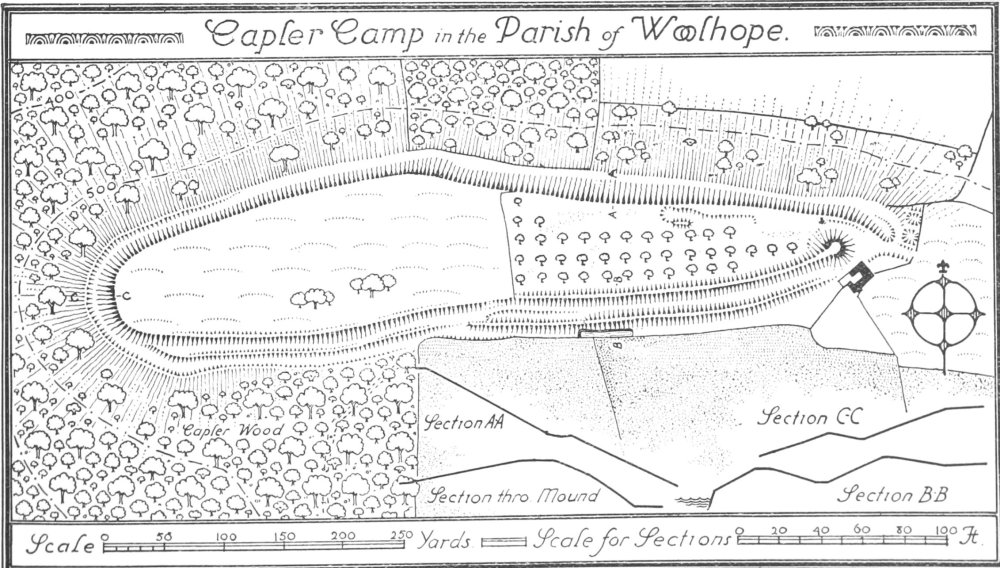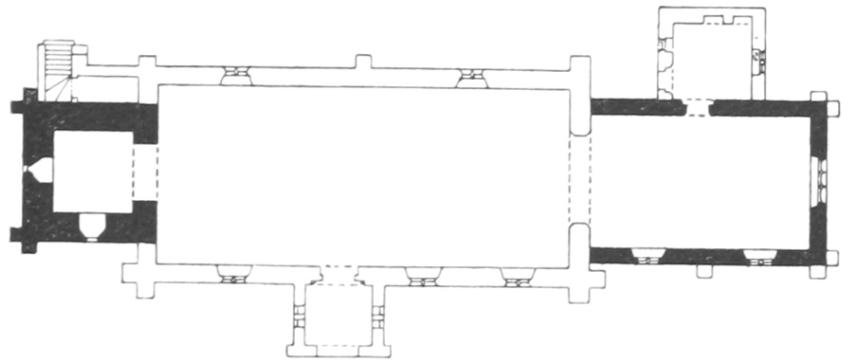An Inventory of the Historical Monuments in Herefordshire, Volume 2, East. Originally published by His Majesty's Stationery Office, London, 1932.
This free content was digitised by double rekeying. All rights reserved.
'Yarkhill', in An Inventory of the Historical Monuments in Herefordshire, Volume 2, East(London, 1932), British History Online https://prod.british-history.ac.uk/rchme/heref/vol2/pp223-225 [accessed 19 April 2025].
'Yarkhill', in An Inventory of the Historical Monuments in Herefordshire, Volume 2, East(London, 1932), British History Online, accessed April 19, 2025, https://prod.british-history.ac.uk/rchme/heref/vol2/pp223-225.
"Yarkhill". An Inventory of the Historical Monuments in Herefordshire, Volume 2, East. (London, 1932), British History Online. Web. 19 April 2025. https://prod.british-history.ac.uk/rchme/heref/vol2/pp223-225.
In this section
96 YARKHILL (C.c.)
(O.S. 6 in. XXXIV, N.E.)
Yarkhill is a parish 7 m. E.N.E. of Hereford. The church is the principal monument.

Capler Camp in the Parish of Woolhope.
Ecclesiastical
(1). Parish Church of St. John the Baptist stands in the S. part of the parish. The walls are of local sandstone rubble with dressings of the same material; the roofs are covered with tiles and stone slates. There appears to have been a church here of c. 1200 as evidenced by some capitals at the vicarage, the re-set S. doorway and probably the tower-arch. The Chancel was re-built at some uncertain period and the West Tower late in the 13th century; the top stage is probably an addition of 1466 (Reg. Stanbery). The Nave was re-built in 1862 probably on the old foundations, the chancel drastically restored at the same time, the South Porch re-built and the North Vestry added.
Architectural Description—The Chancel (28 ft. by 17 ft.) has no ancient features.

The Church, Plan
The Nave (52¼ ft. by 26½ ft.) has been entirely re-built, but has a restored and re-tooled S. doorway (Plate 15) of c. 1200; the two-centred arch is of two orders, the inner roll-moulded and continuous and the outer chamfered and springing from modern attached shafts with old foliated capitals and moulded bases; the chamfered label has dog-tooth ornament.
The West Tower (10 ft. square) is of three stages with moulded plinth and embattled parapet, with grotesque gargoyles and the stumps of pinnacles. The tower-arch is probably of c. 1200 and is two-centred and of one chamfered order with chamfered imposts. In the S. and W. walls are late 13th-century windows of a single trefoiled light; higher up in the W. wall is a window of the same date and of two trefoiled and transomed lights under a two-centred label with defaced stops at the ends and apex. The second stage is set back considerably on the N., S. and W. sides; in the E. and N. walls are windows of a single trefoiled light and in the S. wall is a similar window with a moulded label and three head-stops; in the W. wall is a window of two trefoiled lights. Between this stage and the bell-chamber, except on the S., is a line of corbels of the former parapet, removed when the 15th-century top-stage was added; one corbel on the E. side is carved with a head. The bell-chamber has, in the E. wall, a single-light and in the other walls a two-light window, all with trefoiled heads; the top cusps in the E., S. and W. windows are not pierced.
The Roof of the nave is of mediæval date, re-set, and is of trussed-rafter type ceiled at the collars. The modern roof of the porch incorporates some 13th-century timbers, two purlins (Plate 19) with dog-tooth ornament and two cusped wind-braces similarly enriched.
Fittings—Bells: four; 1st, 2nd and 3rd by John Martin, 1671; 4th by John Finch, 1636. Chest: of hutch-type with moulded upper and lower edge to front, three lock-plates and hinges, 17th-century. Churchyard Cross: In S. porch—over S. doorway, head of cross (Plate 46), set in wall and carved with a Crucifixion with the Virgin and St. John under a trefoiled and gabled head, 14th-century. Font (Plate 53): round bowl with scalloped under-side, necking and hollowed base, c 1200. Monuments: On vestry—on external N. wall, (1) to Francis Stedman, 1646, stone tablet with moulded and enriched surround. In churchyard—against E. wall, (2) tapering slab with defaced head in high relief at top, 13th-century; near S. porch, (3) to James Wofon (?), 1710, head-stone; (4) to James Parry, 1700, head-stone. Seating: In upper part of tower—bench with turned legs and moulded rails, early 17th-century. Miscellanea: In S. porch—over outer archway inside, 13th-century label-stop; on N. wall, wood fragment carved with interlaced circles and foliage or fruit, 15th-century. In tower—stone bowl with gadrooned outer surface, probably early 18th-century. At vicarage—two scalloped respond-capitals, c. 1200. In porch—small stone mortar.
Condition—Good.
Secular
(2). Homestead Moat, 50 yards S. of the church, is of roughly rectangular form. In the adjoining field, to the N.E., is a dry ditch with a right-angled bend.
(3). Showle Court, house, outbuilding and moat, 1,160 yards N.N.E. of the church. The House is of two storeys with cellars; the walls are timber-framed and partly faced with brick and the roofs are tiled. It was built early in the 17th century on an H-shaped plan with the cross-wings at the N.W. and S.E. ends. There are 18th-century and modern additions on the N. and N.W. Inside the building are some exposed ceiling-beams.
The Outbuilding, N.W. of the house, is timber-framed, with a thatched roof. It was built in the 17th and extended in the 18th century.
The Moat, S.E. of the house, formerly enclosed a roughly rectangular island, but is now fragmentary.
Condition—Of house, good.
Monuments (4–15)
The following monuments, unless otherwise described, are of the 17th century and of two storeys, timber-framed and with tile or slate-covered roofs. Most of the buildings have exposed external framing and internal ceiling-beams.
Condition—Good or fairly good.
(4). Cottage, 100 yards W. of the church, has a thatched roof.
(5). Stokebridge Farm, house, 1,440 yards S.W. of the church, has been partly re-faced in stone.
(6). Castle Farm, house and barns, 1,500 yards W.N.W. of the church. The House is of two storeys with cellars and attics. The main block, with the N.E. cross-wing, was built in the 16th century. There are modern additions at both ends. The upper storey originally projected at one end of the cross-wing but has been under-built; it has an original moulded bressummer. The main block has been re-faced in stone.
The Barn, on the N.W. side of the yard, is of six bays and is roofed with corrugated iron. The barn S.W. of the yard is of five bays and is partly stonebuilt.
(7). The Castles, house and outbuilding, 140 yards N. of (6). The House is of two storeys with cellars and attics and is of L-shaped plan with the wings extending towards the S.W. and N.W. The walls are plastered.
The Outbuildings, S.E. of the house and on the S.W. side of the front garden, are both of the 17th century.
(8). Castle Cottage, S.E. of (7), has a thatched roof.
(9). Drythistle Cottage, nearly 1¼ m. N.W. of the church, has a thatched roof.
(10). Garford Farm, house, ½ m. N.W. of the church, is of two storeys with cellars and attics. It is of T-shaped plan with the cross-wing at the N.E. end and modern additions on the N.W. side.
(11). Jugs Hole, cottage, 260 yards N.E. of (10), has a corrugated iron roof. Inside the building are two original moulded ceiling-beams.
(12). Oakleigh House, on the S. side of the road nearly 1 m. N.N.E. of the church.
(13). Cottage, 60 yards E. of (12).
(14). Monksbury Court, about 1 m. N.E. of the church, is of 18th or 19th-century date except for one wing.
(15). Cottage, on the S. side of the road at Newtown, over 1½ m. N.N.E. of the church, has a thatched roof.